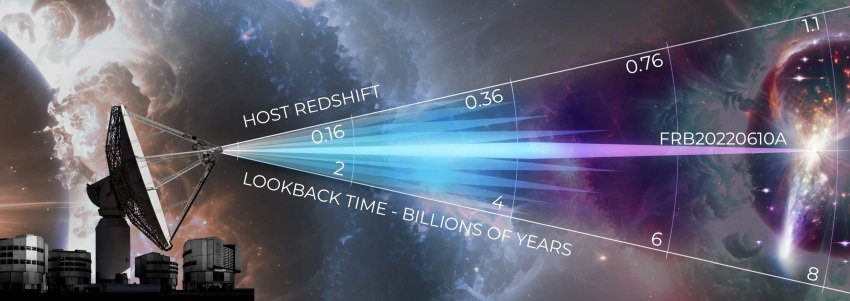A global team led by Australian astronomers have discovered a record-breaking fast radio burst (FRB) that offers a way to measure the “missing” matter between galaxies.
On 10 June 2022 CSIRO’s Australian Square Kilometre Array Pathfinder (ASKAP) radio telescope, on Wajarri Yamaji Country in Western Australia, detected the FRB. At about 8 billion years old, it eclipses the team’s previous record by 50%.
Fast radio bursts are brief pulses of radio emissions that originate from distant sources outside the Milky Way. The source of this burst, which has been named FRB 20220610A, is a group of 2 or 3 merging galaxies.
FRB 20220610A released the equivalent of the Sun’s total emissions over 30 years in just milliseconds.
“Using ASKAP’s array of dishes, we were able to determine precisely where the burst came from,” says Dr Stuart Ryder of Macquarie University, Australia, the first author on the paper published in Science.
“Then we used the European Southern Observatory (ESO) Very Large Telescope (VLT) in Chile to search for the source galaxy, finding it to be older and further away than any other FRB source found to date, and likely within a small group of merging galaxies.”

Weighing the universe using FRBs
The signals that FRB’s produce can be used to infer information about the cosmic environments they pass through as they travel through space.
They can even be used to weigh the universe by detecting the matter that exists between the galaxies. This was first demonstrated by the late Australian astronomer Jean-Pierre ‘J-P’ Macquart in a 2020 paper in Nature.
“J-P showed that the further away a fast radio burst is, the more diffuse gas it reveals between the galaxies,” says Ryder.

“This is now known as the Macquart relation. Some recent fast radio bursts appeared to break this relationship. Our measurements confirm the Macquart relation holds out to beyond half the known Universe.”
Associate Professor Ryan Shannon of Swinburne University of Technology, Australia, adds that the cause of these massive bursts of energy is still unknown.
“While we still don’t know what causes these massive bursts of energy, the paper confirms that fast radio bursts are common events in the cosmos and that we will be able to use them to detect matter between galaxies, and better understand the structure of the Universe.”

Current methods to estimate the mass of the Universe give conflicting answers.
“If we count up the amount of normal matter in the Universe – the atoms that we are all made of – we find that more than half of what should be there today is missing,” says Shannon.
“We think that the missing matter is hiding in the space between galaxies, but it may just be so hot and diffuse that it’s impossible to see using normal techniques.
“Fast radio bursts sense this ionised material. Even in space that is nearly perfectly empty they can ‘see’ all the electrons, and that allows us to measure how much stuff is between the galaxies.”
The international SKA telescopes currently under construction in Western Australia and South Africa will allow scientists to detect even older and more distant FRBs.

Cosmos is a not-for-profit science newsroom that provides free access to thousands of stories, podcasts and videos every year. Help us keep it that way.
Support our work today.
